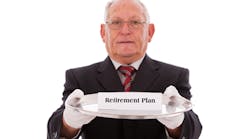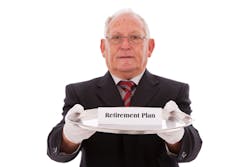Would you choose 96% or 4% for your retirement from dental practice?
If you chose 96%, then you did not choose well. You chose the approximate percentage of dentists that, according to the ADA, cannot retire at age 65 and maintain their lifestyle. Notice that the statistic does NOT indicate dentists cannot retire, but it does indicate that retirement may not be as leisurely as doctors hoped.
Why is it that dentists cannot afford to retire at the same level of comfort they enjoy while they are producing? Dentistry is a great profession with the opportunity to make a nice income. It’s reasonable to say that many dentists have a retirement account, yet 96% of dentists are still not ready. Why are so many dentists under-prepared when the day comes to hang up the handpiece?
In my years of focusing on the dental community in my financial planning practice, I believe it amounts to a lot of little things that all add up. Consider that many dentists are challenged by — poor collections, paying too much in taxes, being stretched too thin personally, bad advice from bad sources, staffing issues, holes in the schedule/not enough patient encounters, debt, poorly timed real estate purchase, assumption of preparedness, mental accounting (spending the same dollar twice), selling practice for too little or asking too much, and a market flooded with practices for sale.*
Unfortunately, there is an army of consultants and advisors ready to tell dentists how to fix things, but in my experience, none of them truly understand the issue dentists face today. One of my close dentist friends told me one of his advisors informed him that “dental practices cannot be sold.” A trusted advisor actually believed that the doctor’s practice did not have a marketable value.
The source of advice can truly have a major impact on your decisions.
ALSO BY WILL PARRISH:The 11 commandments of risk management for the dental professional
The 11 commandments of risk management for the dental professional Part II
There is also an unseen force impacting the dentist’s ability to retire today, and it has to do with when the dentist started practicing. Most dentists wanting to retire soon likely purchased or started their practice somewhere between 1978 and 1984. Statistics show this timeframe had the largest graduating class of dentists American history. A dentist who began practicing in that timeframe had a lot of competition.
Also remarkable for that time was that there were very few dentists retiring, meaning there were not a lot of practices on the market, which likely drove up the inflation adjusted price to buy a practice at that time. If a doctor chose to start a practice from scratch, he or she had the challenge of building a patient base over the next few years. Either way, starting to practice between 1978 and 1984 set forth a challenge.
What does that mean today? We are seeing the largest group of dentists beginning to retire, and the market has plenty of practices for new dentists to choose from. The new dentists are also enjoying another benefit — a sharp decline in the number of graduates, which means less competition, and fewer new docs to buy up all of those practices on the market.
What can be done? Unfortunately, there are no quick and easy answers.
One thing you can do is seek out good advice from professionals who have a track record of helping dentists solve these problems. It might be time to take action, and actually plan to retire. You can plan too late, but you can’t plan too early.
For example, I have spent the last decade specializing in financial planning for dentists. In that time, I have been able to surround myself with experts in a variety of other professions — attorneys, CPAs, transition specialists, dental business coaches, and HR consultants. By surrounding myself with these other professionals, I have been able to gather a great deal of information about the dental business and dentists in general.
Dentists can accomplish the same thing, and should surround themselves with advisors and professionals that have a proven track record serving dentists. I founded Southeast Dental Advisors, Inc., (SeDA) as a free resource for dentists who need professional help. There are no kickbacks, no strings, and no fees. SeDA is simply a group of like-minded professionals who have come together to share information and better serve the dental market.
If you think that a conversation with a professional who specializes in dentistry would be helpful for you, reach out to me or visit www.southeastdentaladvisors.com.
Watch for future articles where I will discuss the challenges listed here in depth, and their impact on a dentist’s ability to retire. I’ll also share my Practice Conversion Strategy for Dentists™, designed to help address many of these concerns.
*The ADA reports on their website to potential dental students that “Large numbers of dentists are expected to retire in the next 20 years, creating a need for new dentists.”







